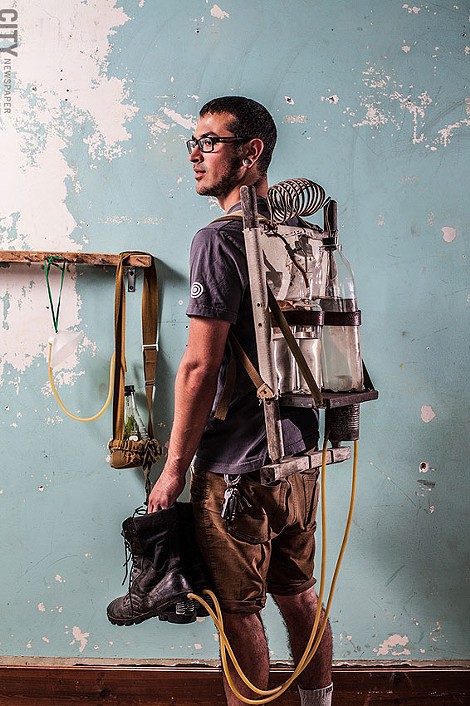[
{
"name": "500x250 Ad",
"insertPoint": "5",
"component": "15667920",
"parentWrapperClass": "",
"requiredCountToDisplay": "1"
}
]
Mention Rochester Institute of Technology and images of semi-conductors and integrated circuit boards probably come to mind. The university has deservedly earned a reputation for its technology muscle. Even the campus' sleek brick exterior evokes the futurism of a modern laboratory, which in some ways makes RIT the least likely place to find a school focused on crafts.
But then again, RIT may be just the place for such a school, since crafts is a field that harmonizes the past with the present: centuries-old skills and traditions mixed with the latest technology.
The School of American Crafts is one of RIT's little-known gems. Founded at Dartmouth College and relocated to RIT in 1950, SAC is the oldest craft school in the U.S. And it is recognized as a leader in the field of arts and crafts, attracting luminary faculty and producing some of the best talent in the field. Hans Christensen, Fred Meyer, Frans Wildenhain, Wendell Castle, and Albert Paley have taught at SAC.
The school, which has about 100 undergraduate and graduate students, offers BFA and MFA degree programs in glass, ceramics and ceramic sculpture, metal crafts and jewelry design, and woodworking and furniture design.
A recent $2 million renovation helped RIT expand the school to a 15,000 square foot state-of-the-art space. Whether it's a glass hot shop, a metal forge, or a wood shop that has almost every saw and tool conceivable, students in each department have top-notch studio facilities at their disposal.
But it's not just the facilities and the faculty that distinguish SAC from other craft schools. It helps that the school is nestled in a well-respected institution known for engineering and design. And its location, roughly three hours north of the Corning Museum of Glass, is also an asset.
There's SAC's history to consider, too.
"One of the most unusual aspects of the school was the philosophic construct: 'a community of artisans working together,'" says Leonard Urso, metals professor. "And that's what we maintain to this day: all students from all levels meet in the studios at the same time. The community is always together and students learn from each other."
Most craft schools programs offer little studio time, Urso says. At SAC, students must make a serious commitment to working on their craft. They are required to spend roughly six hours three days a week in their studios, and that's in addition to their other academic commitments.
The school is steeped in history and traditional techniques. Students may be asked to create a small table without using power tools, for example. But they're also required to use technology. And they need to develop an intimate understanding of the material they're working with so they can master technique well enough to research, explore, and experiment.
"Knowing the material and how to work with it makes you a better designer, especially in wood," says Richard Tannen, a professor in the department of woodworking and furniture design. "It's a living, breathing material. It has properties, such as the way it takes on moisture that expands it along its width, but not its length because of its cell structure. So, wood's biology is intimately related to the techniques to work with it successfully."
Although parents often clamor for arts-rich programs in elementary and secondary schools, seeing their children enroll in a college degree program for artisans is all together different. While it may not seem like the most practical choice, many SAC students say they can't see themselves doing anything else. And many say their parents are supportive.
Wil Sideman, a first year grad student in the glass department, grew up in central Maine, where many people still have wood shops in their garages and basements. Working with his hands is something he says he knew he wanted do from an early age.
"I was motivated by a person who was making a canoe in his back yard," he says.
Sideman also spent time on a pottery wheel, and he was interested in photography. But it was glass that captured his imagination. And his parents supported him from the beginning.
"My parents are very open-minded," he says. "When I said I wanted to go to art school, they were happy I was going to school for anything."
Yunus Lowenthal, a senior in the ceramics department, enrolled in RIT for pre-med, but soon changed directions. He thought he wanted to be a forensic scientist, he says, but quickly realized the work wasn't as interesting as he thought it would be.
Lowenthal creates earthy-looking stoneware bowls, plates, and other objects. He was raised in an Islamic community, and his work lightly reflects a Middle Eastern design.
Lowenthal says he's not worried about how he's going to make money.
"I'm happy doing this," he says.
There's an allure to clay, metal, glass, and wood that almost seems wired in human DNA. Using these basic materials to create art or functional objects is what makes us human, some students say. Making tools to solve problems and create other objects may be the proverbial jumping-off point between the great apes and modern humans.
"There's a huge history to ceramics that goes back 10,000 years," says Jane Shellenbarger, assistant professor in the ceramics department. "There are so many cultures that took the material to such great heights. We would miss out if we didn't understand that."
Glass can mimic the appearance of other materials, which makes it both attractive and demanding, says Robin Cass, the incoming chair of SAC.
"It's really seductive," she says. "Glass can be cut, stretched, blown, and folded into countless forms that resemble everything from wood to precious gems. You can come at it when it's hot or cold, and there's almost no limit to what you can make out of it."
There's also a social component to working with hot glass, since it typically requires two people working together.
"The team effort is huge," Cass says. "You have to be able to communicate with each other."
And there's a time-sensitivity to working with glass, she says, because it becomes brittle as it cools.
The furnaces used for glass blowing usually operate at about 2,150 degrees. Flame working, which resembles soldering metal with a blow torch, heats glass to about 3,000 degrees. At that point, the glass can be shaped, manipulated or fused to another piece of glass.
The national conversation about student debt and employment after college isn't lost on SAC's faculty. RIT is not, for many students, an inexpensive school. And most Department of Labor reports do not show great demand for glass blowing or furniture making.
But earning a living in crafts is not impossible, either.
"There's still a cottage industry for that craftsperson who likes designing a unique piece and making it," says the metals department's Urso. "A good number of our people do that. The way they go about making a living is by doing the large craft trade shows like the Philadelphia [Museum of Art] Craft Show."
But there are multiple pathways to earning a living, Urso says.
"You have people who know everything about material and process, and they understand how everything works," he says. "They might go to work for, let's say, the design department at a high-end jewelry store, because they're able to take a design and follow it all the way through the manufacturing, packaging, pricing, and getting it out the door."
Many students know they're not preparing for 9 to 5 jobs, and that they may be more likely to find work in industries dependent on handmade objects or specific skills. For instance, some students in the furniture design department find work in the yacht-building industry.
Many students are working toward finding their niche as an artisan. They need to continue working and producing their art in a studio, which may mean working in the corporate world or some other field until they get established, SAC faculty members say.
And earning an MFA can open doors, particularly if a student is interested in teaching at the college level.
There are employment opportunities out there for students who are persistent, says Benjamin Cobb, a 2001 SAC graduate. Cobb is the manager of the glass hot shop at the Tacoma Museum of Glass in Tacoma, Washington.
Students have to be committed and develop their craft, he says.
"You could tell who was going to make it when I was there," he says. "It was the same group of students in the studio day and night."
Latest in News
More by Tim Louis Macaluso
-

RCSD financial crisis builds
Sep 23, 2019 -

RCSD facing spending concerns
Sep 20, 2019 -

Education forum tomorrow night for downtown residents
Sep 17, 2019 - More »






